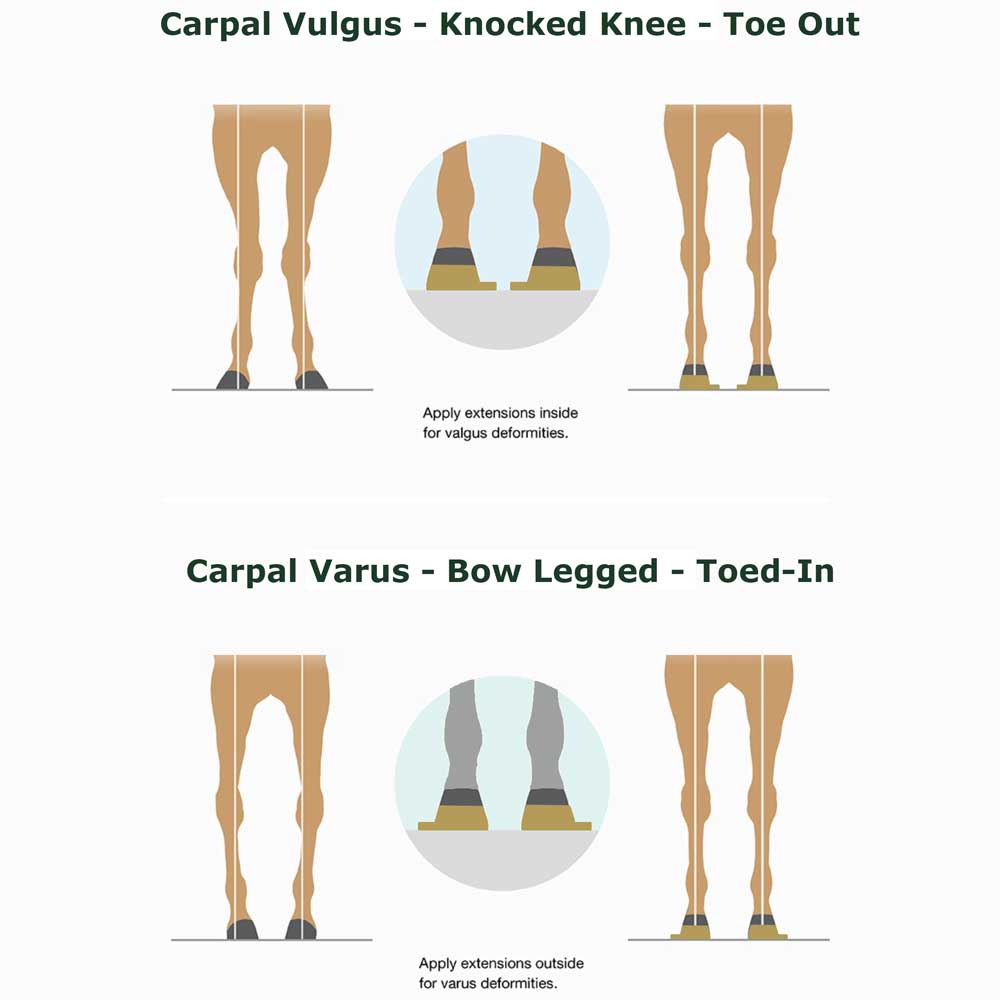We continue our series about common hoof problems in horses with a look at Laminitis and Founder in Horses, White Line Disease, Thrush, and Limb Deformities in Foals.
Healthy v Distorted horse foot

Laminitis and Founder in Horses

Laminitis in horses is inflammation and damage of the tissue between the hoof and the underlying coffin bone. In severe cases it can progress to founder, where the hoof and coffin bone become separated and the coffin bone can rotate, leading to severe pain.
Laminitis commonly results from endocrine diseases such as equine metabolic syndrome (EMS) or pituitary pars intermedia dysfunction (PPID), but other causes can include weight bearing on supporting limbs due to injury and excessive sugar intake from grain or lush pasture.
Laminitis in horses is irreversible. Treatment must be initiated to minimize further damage and recovery outcomes vary widely from horse to horse.
Read more about Laminitis in the following articles:
https://formahoof.com/supportive-laminitis-treatment
https://formahoof.com/treating-laminitis-broodmares
https://formahoof.com/feeding-caring-laminitis
https://formahoof.com/supporting-laminitis-rehabilitation
FormaHoof is uniquely suited to treating laminitis in horses as it encapsulates the damaged hoof, protecting and supporting the sensitive internal structures. This prevents further deterioration, whilst also immediately reducing pain and improving the horse’s ability to move.
The resulting comfort also reduces overall stress levels, leading to a faster recovery as the horse can quickly return to a regular routine. FormaHoof will clearly NOT cure a disease like Laminitis or Founder but can support your horse during their rehabilitation by providing drug-free comfort and help to prevent further damage.
How long this will take depends on the condition your horse is in. Most horses can return to barefoot within very few application cycles, whilst severe cases may need a little longer.
Did you know?
Common side effects of laminitis include seedy toe or white line disease, seromas (blood pockets) and/or abscesses. This is nothing unusual but needs to be treated immediately to avoid further damage.

White Line Disease

White line disease in horses is also known as seedy toe, hoof-wall disease, hollow wall, Candida, or onychomycosis.
When opportunistic bacteria or fungi invade and destroy the hoof-wall tissue, white line disease can, if left untreated, affect the entire inner hoof wall, resulting in lameness, hoof wall separation and loss of stability of the entire hoof.
A healthy hoof acts as a barrier against invasion of these microorganisms, but hoof cracks or fissures can allow the bacteria or fungi to enter and infection to set in. White line disease can also be a symptom of laminitis.
White line disease in horses can be healed. The infected areas need to be removed and, depending on the severity, a hoof wall resection may be needed. The infected area needs to be disinfected and kept clean and dry for a period of time.
More information about white line disease, the causes, treatment and more can be found at:
https://formahoof.com/treating-white-line-disease
https://formahoof.com/dealing-with-white-line-disease
Horse Hoof Thrush

Thrush is a common anaerobic bacterial infection of the horse’s hoof tissue characterized by a black, necrotic (dead), foul-smelling material. Thrush typically affects the central frog or grooves adjacent to and in the middle the frog (collateral sulci).
Symptoms of thrush in a horse’s hoof include:
• Discharge from the crevice of the hoof
• Obvious sensitivity of the hoof or leg
• Very foul smell from the hoof
• Pulsation in some cases
Other signs of pain and discomfort in your horse include restlessness or loss of appetite.
To treat hoof thrush in horses, you should move the horse away from dirt and wet to a clean, dry environment. The infected hoof should be cleaned, necrotic debris from within the affected frog should be removed by a farrier or veterinarian, medicated and kept clean. The horse should remain in dry stall conditions and the frog should be cleaned and treated regularly until the infection is controlled and the tissues healed.
FormaHoof can be an excellent solution to imitate controlled and medicated conditions, without the need for daily dressing changes. Due to the encapsulation of the hoof, horses may also be turned out sooner.
Limb Deformities And Conformation Faults In Foals
Young foals can have crooked legs (either front, hind, or both), also known as Angular Limb Deviation or Deformity (ALD).
There are various causes of such deformities which include:
• premature birth
• twin pregnancy
• placentitis
• perinatal soft tissue trauma
• flaccidity or laxity of the soft tissue structures surrounding the joints
Furthermore, developmental factors can cause deformities in young horses, including:
• unbalanced nutrition
• excessive exercise
Most foals will be born with some degree of limb deviation, mostly due to ligament laxity and muscle weakness, which in most cases will correct itself as the foal exercises and gets stronger.
If the cuboidal bones are not fully formed, however, there is risk of the incompletely formed bones being crushed from exercise and uneven load that is placed on the joint due to the laxity. In these cases, once the bones have fully formed/calcified, an ALD may result due to the abnormally shaped cuboidal bones.
There are two general terms used to describe these deviations:
• Valgus refers to an outward deviation of the limb
• Varus refers to an inward deviation of the limb

Whilst angular limb deformity is diagnosed by watching the foal stand and walk, radiographic (x-ray) examinations may be required to confirm the site and severity of the angulation, whether the growth plate (epiphysis) or small bones of the knee or hock are involved and what is the best form of treatment. Long x-ray plates are often used, so that straight lines can be drawn through the long bones to confirm precisely where the deviation occurs and by how much (angle).
Read more about foal hoof care, angular limb deformities, conformation faults and how they can be treated at
https://formahoof.com/foal-conformation
https://formahoof.com/horse-breeders-hoof-care-guide














